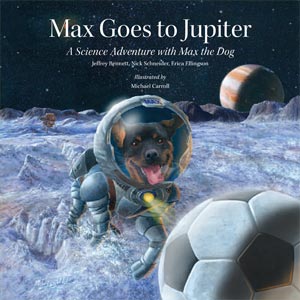(1) Carl Sagan Full Quotation
The Big Kid Box on p. 14 of Max Goes to Jupiter ends with an excerpt from a quote from Carl Sagan. The full quotation is below. It is even better when you can hear Dr. Sagan speaking the words, or see the words on more elegant background. Here are a few of my favorites:
Video of the quote with Sagan’s voice:
There is also a beautiful poster of this quote at http://arnett.us.com/psc/guest/SaganPoster1.pdf, and a nicely done cartoon version at http://zenpencils.com/comic/100-carl-sagan-pale-blue-dot/.
“Look again at that dot. That’s here. That’s home. That’s us. On it everyone you love, everyone you know, everyone you ever heard of, every human being who ever was, lived out their lives. The aggregate of our joy and suffering, thousands of confident religions, ideologies, and economic doctrines, every hunter and forager, every hero and coward, every creator and destroyer of civilization, every king and peasant, every young couple in love, every mother and father, hopeful child, inventor and explorer, every teacher of morals, every corrupt politician, every “superstar,” every “supreme leader,” every saint and sinner in the history of our species lived there – on a mote of dust suspended in a sunbeam.
The Earth is a very small stage in a vast cosmic arena. Think of the rivers of blood spilled by all those generals and emperors so that, in glory and triumph, they could become the momentary masters of a fraction of a dot. Think of the endless cruelties visited by the inhabitants of one corner of this pixel on the scarcely distinguishable inhabitants of some other corner, how frequent their misunderstandings, how eager they are to kill one another, how fervent their hatreds.
Our posturings, our imagined self-importance, the delusion that we have some privileged position in the Universe, are challenged by this point of pale light. Our planet is a lonely speck in the great enveloping cosmic dark. In our obscurity, in all this vastness, there is no hint that help will come from elsewhere to save us from ourselves.
The Earth is the only world known so far to harbor life. There is nowhere else, at least in the near future, to which our species could migrate. Visit, yes. Settle, not yet. Like it or not, for the moment the Earth is where we make our stand.
It has been said that astronomy is a humbling and character-building experience. There is perhaps no better demonstration of the folly of human conceits than this distant image of our tiny world. To me, it underscores our responsibility to deal more kindly with one another, and to preserve and cherish the pale blue dot, the only home we’ve ever known.”
— Carl Sagan (1934-1996)
(2) Jupiter in the Night Sky
 As explained in the Big Kid Boxes on p. 4-5 of Max Goes to Jupiter, Jupiter is often easy to see in the night sky. Many web sites provide information about whether and where to find Jupiter and other planets in the night sky; here are some that are particularly easy to use:
As explained in the Big Kid Boxes on p. 4-5 of Max Goes to Jupiter, Jupiter is often easy to see in the night sky. Many web sites provide information about whether and where to find Jupiter and other planets in the night sky; here are some that are particularly easy to use:
Astronomy Magazine’s Tonight’s Sky applet: This simple applet appears at the top of this web page; just click on the tab labeled "Mars, Jupiter, and Saturn" to see whether Jupiter is visible and the time at which it rises and sets.
Night Sky Info: This wonderful site, created by a young man in Romania, tells you where to find all the planets in the night sky. Just scroll down to Jupiter and click on the finder maps to see exactly where Jupiter is currently located among the constellations. Highly recommended!
Note: On the above and other astronomy sites, you may sometimes see paid advertisements for horoscopes or other aspects of astrology. Be sure that you don’t confuse astrology with astronomy; although the two words sound much the same — and were often practiced by the same people in ancient times — they have very different meanings today. Astronomy is the science by which we learn about planets, stars, galaxies, and the universe. Astrology arises from ancient superstitions that held that the movements of the planets among the stars of the zodiac could affect our lives. We now know that the planets are too far away to have any gravitational influence on our lives, and tests of the predictions made by astrology show that these predictions come true no more often than would be expected by pure chance. We should not be surprised that astrology doesn’t work. After all, ancient people came up with the ideas of astrology at a time when they thought that Jupiter and the other planets really did move among the constellations, but we now know that is not the case: The planets orbit our Sun, while the stars are other "suns" that are incredibly far away compared to the planets. Moreover, ancient people also assumed that the patterns we see in the constellations had meaning, but we now know that these patterns are illusions that we see from Earth only because we lack depth perception when we look into space; in many cases, the stars that make up the patterns of a constellation are nowhere near each other in reality, because some are much farther away from us than others. This idea is shown with an applet that allows you to see the 3d positions of stars in constellations (for Leo and Scorpio); if you find other web-based applets that you think we might want to post for all readers, please let us know! (Click the contact link above.)
